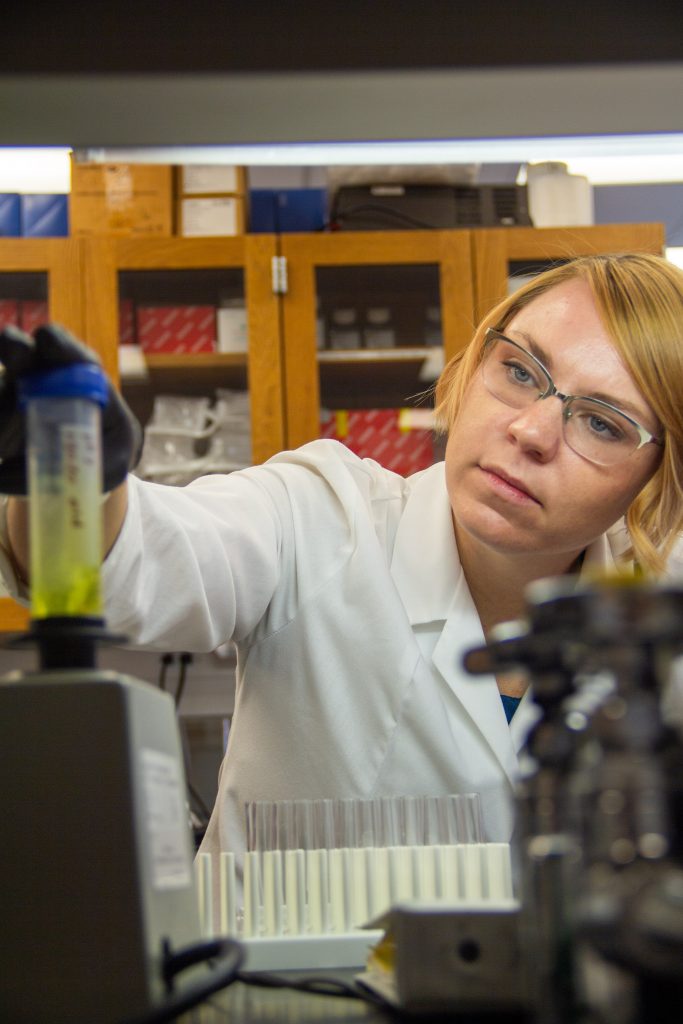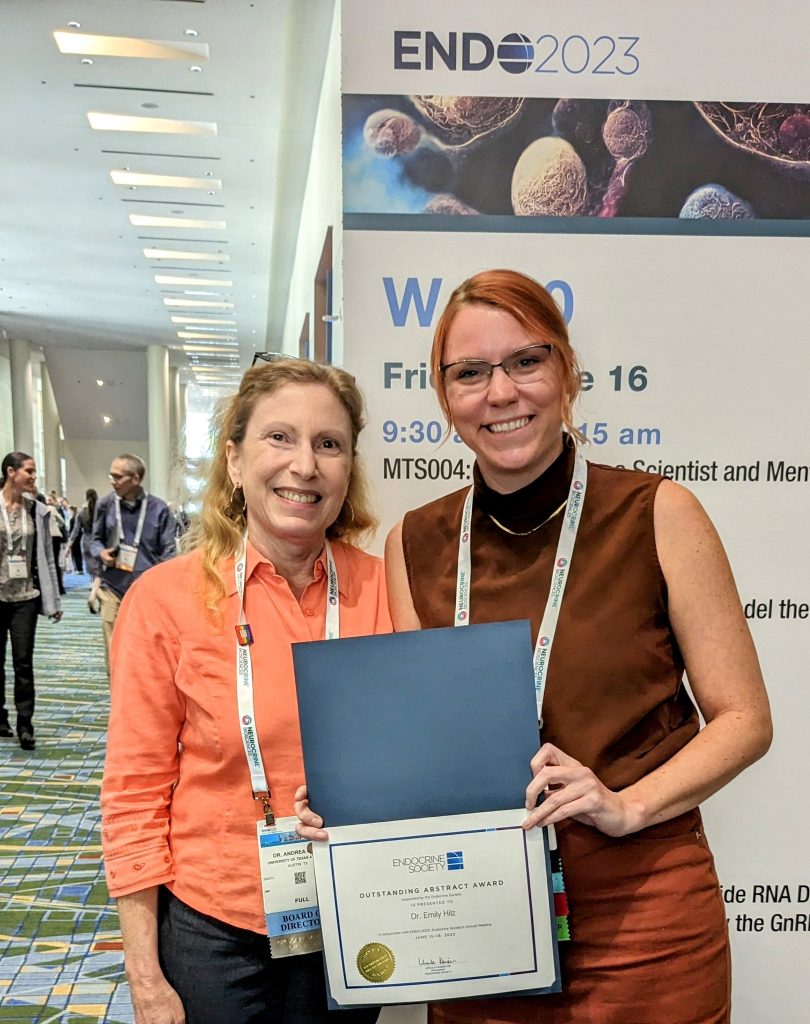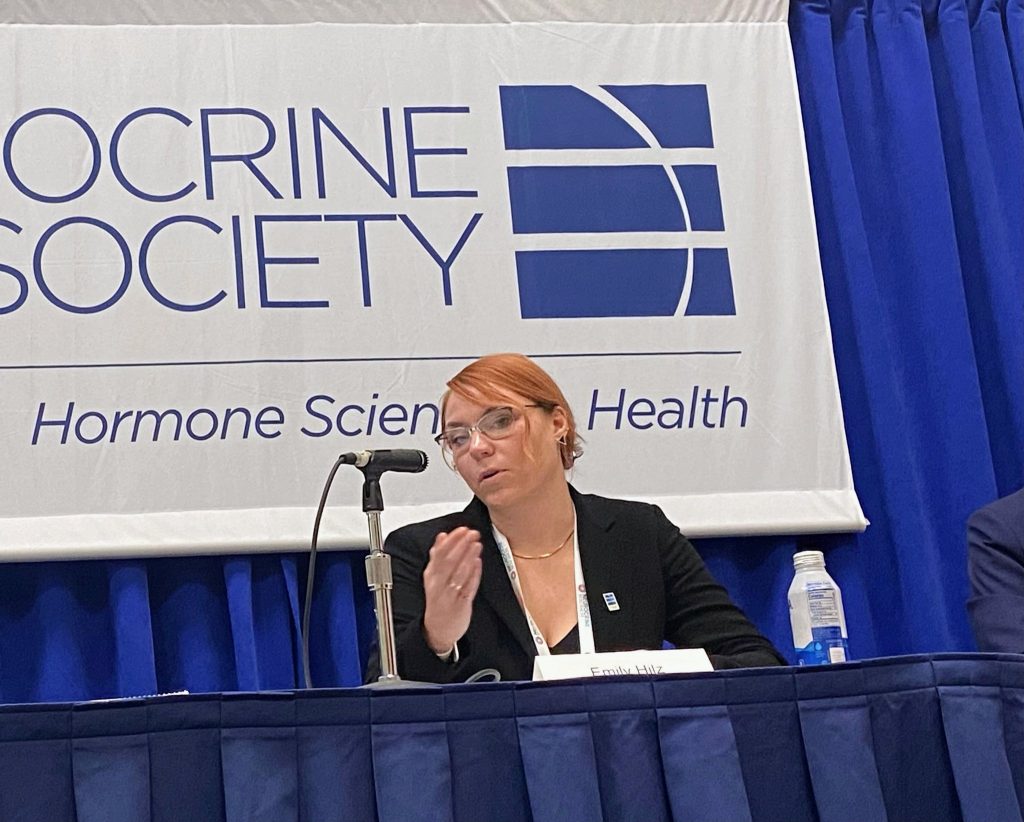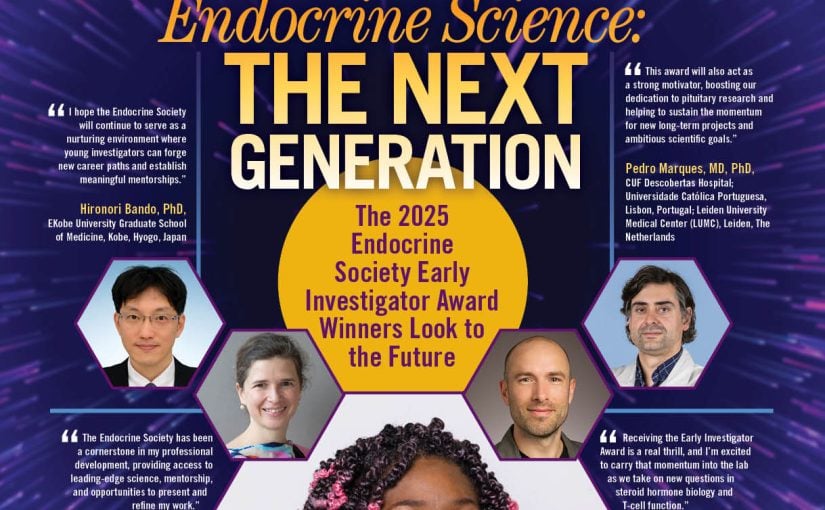
With a keen interest in hormonal research, Emily Hilz, PhD, has become passionate about the dangers of endocrine-disrupting chemicals, especially in beauty products. She talks to Endocrine News about a new app she’s developing to help shield Black women from dangerous products they could be using every day.
A new mobile app developed by Emily Hilz, PhD, a postdoctoral researcher at the University of Texas at Austin, aims to empower Black women as consumers to reduce EDC exposure risk by linking chemicals in their personal care products with their suspected adverse health outcomes.
Hilz recently won Phase 1 of the Department of Health and Human Services (HHS) Endocrine-Disrupting Chemicals Innovator Award Competition to continue developing the app. The competition was created to identify gaps in knowledge and innovative solutions to improving women’s health by reducing EDC exposure risk. The Phase 1 winners received up to $40,000 to expand their projects.
Hilz is a researcher in Andrea Gore’s lab where she studies the effects of EDCs on the brain and behavior, and she recently presented an animal study at ENDO 2023 on how EDCs may raise the risk of cognitive disorders in future generations. According to Gore, upon joining her lab Hilz “established new sophisticated behavioral analyses to determine multigenerational effects of exposures to PCBs, a class of endocrine-disrupting chemical (EDC), in our rat model,” she says. “She is currently seeking to understand which molecular pathways in the brain were most affected by PCB exposures to cause behavioral changes through deep sequencing and bioinformatics.”

“Emily is particularly concerned about exposure of vulnerable populations to EDCs – those early in development, and members of underrepresented groups,” Gore continues, adding “Emily has been a great leader, mentor, and role model, with a team of undergraduate students working under her guidance. The graduate students turn to her often for advice on a range of topics, and the lab has become a better place since she joined us two years ago.”
According to Hilz, the app as a passion project that she developed with her friends that has gotten a lot more attention than she originally anticipated. The researchers are still working on some features, but the app is currently available at endoscreen.org.
Endocrine News recently interviewed Hilz about the app and her work to reduce EDC exposure in Black women:
What was your inspiration for developing the app, and how does it work?
I had the idea for the app prior to hearing about the competition and had spoken to some friends of mine who are now the lead developers about doing this as a passion project where we could all come together to create a tool to help people.I got a lot of inspiration for the app from the talks I heard at an Environmental Endocrine Disruptors conference.
I wanted to create an app that both scans the ingredients in beauty products for EDCs and shares the results with the user so they can take on a more active role in their health. We wanted to focus on the Black community since they are more at risk and products marketed to Black women are a significant source of EDC exposure.
“A lot of products are assumed innocent until proven guilty, and it needs to be the other way around. We should assume these chemicals are causing disruptive health outcomes and prove they’re not before bringing them to market.” — Emily Hilz, PhD, postdoctoral researcher, The Gore Lab, Department of Pharmacology, University of Texas, Austin, Texas
The way the app works is you take a picture of your product’s ingredient label, and the app will read those words and give an output based on the database that we built. The output tells you which chemicals in your products are known EDCs and their associated health outcomes based on current research. It also tells you the number of articles that link that chemical to a health outcome, so you can get an idea of the relative certainty. Users can now read about research related to chemicals they detect in their products and access our educational pages to learn more about EDCs.
Why are you so passionate about this issue, and why do you think Black women are disproportionately affected by EDCs?
I’ve always been interested in hormonal research. When I joined Dr. Gore’s lab, I didn’t fully understand the repercussions of EDCs. I’ve been in the lab two years now, and as I’ve gotten more involved in the field, it’s shocking and upsetting to me how prevalent and under regulated these chemicals are.
I’m passionate about raising more awareness around EDCs and want to add my voice to the many voices at the Society that are calling for action because this is such a serious health crisis.
Some reasons Black women may be inordinately exposed to EDCs include socioenvironmental factors like natural hair discrimination. Chemical straighteners and hair relaxers are rife with EDCs. There is also colorism and the use of skin lightening creams which are similarly disruptive. Some research suggests that Black women are also more likely to use douches which have EDCs and reinforce the stigma around feminine hygiene. Other factors include things like living in areas that may be close to EDC producers and consumption of foods that are packaged with EDCs.

Can you share some highlights of working with Dr. Andrea Gore and how she has been a mentor to you?
My role in the Gore lab is as a postdoctoral fellow. I received a national research service award (F32) from the National Institute of Environmental Health Sciences to train with Dr. Gore and to conduct my own research exploring the neurobehavioral effects of intergenerational EDC exposure. Andrea has been a great mentor to me, introducing me to the important field of EDC research and helping me secure funding and supporting my training as a physiologist and molecular biologist. Andrea is a passionate mentor who emphasizes diverse perspectives and inspires great work from the people around her.
Can you expand on the research you are currently working on related to EDC exposure?
My F32-funded research has revealed that behavioral effects of EDCs seem to emerge later along the genetic line (e.g., grandchildren of exposed individuals show cognitive disruptions). Currently we’re exploring the molecular underpinnings of those effects — using 3′ targeted sequencing (TAGseq) to quantify differentially expressed genes in the brains of grandchildren of EDC-exposed rats. This is data we’re delving deeper into every day — but it seems EDCs alter brain myelination and synaptic signaling to cause those cognitive changes. It seems the behavioral effects are more robust in females, but the biological changes are more apparent in males.
“I know it can feel hopeless and overwhelming, and we don’t want people to be discouraged and think ‘if everything is toxic, nothing is toxic.’Even small exposure changes are associated with better health, so while you can’t get rid of every EDC in your environment, you can still reduce your exposure and improve your long-term health.” — Emily Hilz, PhD, postdoctoral researcher, The Gore Lab, Department of Pharmacology, University of Texas, Austin, Texas
I work on many projects with the Gore lab. We’ll be publishing two papers of six generation behavior experiments with me as lead author later this year that shows a) repeated EDC exposure results in increasingly robust behavioral changes; b) those changes are sex specific; and c) parental lineage and the mixture of EDCs we’re exposed to determines our health outcomes. We just began using a new model (“neuromix”) where we expose rats to complex EDC mixtures that are much more environmentally relevant (as humans are exposed to many different EDCs all at once). My work in that project involves both behavior and molecular work, as well as using mass spectrometry to determine if and how much of the EDC mixture components are making it into brain and the gonad (and maybe directly altering the genetic makeup of those tissues in a way that ultimately gets carried along to offspring). Of course, a lot of hands touch these projects besides mine.
What’s next for the app?
We are working on the capability to scan product barcodes to make the app easier to use. We’ve also added some optional demographic survey information that users can fill out, which we hope to be able to use to learn more about patterns of exposure to endocrine disruptors as well as efficacy of the web app as an educational tool.
We plan to get more Black women using the app by reaching out to the local community, Black interest groups, and Black beauty influencers. We’re also working on a viral online campaign on whether or not your skincare routine passes the endocrine challenge to grab people’s attention.
What are a few simple steps people can take to reduce EDC exposure?
A good start would be buying fragrance- /dye-free products and being careful with products that say phthalates and BPA free. In many cases, these harmful chemicals are being substituted with other chemicals that are just as if not more dangerous. Outside of personal care products, move from plastic to glass Tupperware and wash your hands as much as possible!
“I’m passionate about raising more awareness around EDCs and want to add my voice to the many voices at the Society that are calling for action because this is such a serious health crisis.” — Emily Hilz, PhD, postdoctoral researcher, The Gore Lab, Department of Pharmacology, University of Texas, Austin, Texas
I know it can feel hopeless and overwhelming, and we don’t want people to be discouraged and think ‘if everything is toxic, nothing is toxic.’Even small exposure changes are associated with better health, so while you can’t get rid of every EDC in your environment, you can still reduce your exposure and improve your long-term health.
Anything else you want to add?
A lot of products are assumed innocent until proven guilty, and it needs to be the other way around. We should assume these chemicals are causing disruptive health outcomes and prove they’re not before bringing them to market.
If you’re interested in working with the Society to raise awareness around EDCs and advocate for better regulation, visit: endocrine.org/topics/edc/what-you-can-do.
Williams is the senior communications manager at the Endocrine Society. She wrote about the EndoCares event during ENDO 2022 in the September 2022 issue of Endocrine News.

